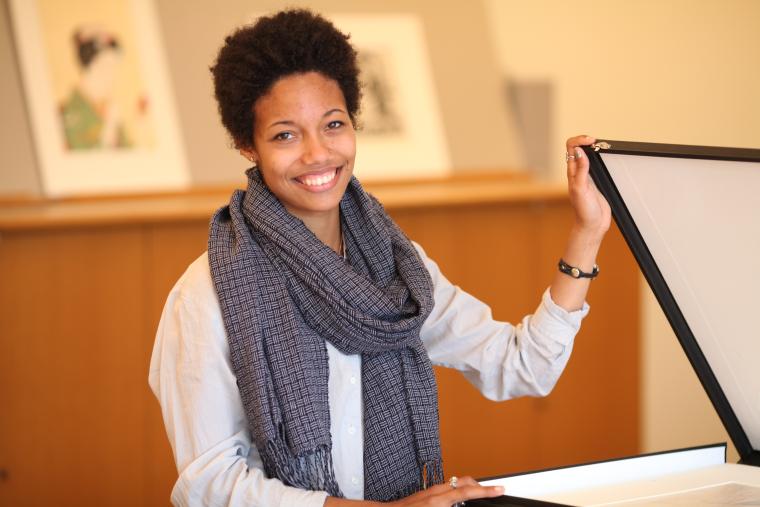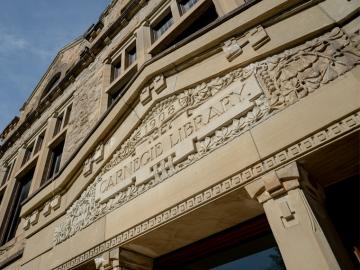Former Fulbright Scholar Curates Exhibition at MoMA
November 15, 2016
Justine Goode

What does it feel like to mount an exhibition at a major art museum only two years after graduating college? “Surreal,” says Dessane Cassell ’14, whose show Making Faces: Images of Exploitation and Empowerment in Cinema opened at the Museum of Modern Art (MoMA) in New York this October. “It was really thrilling, and something that’s still kind of sinking in, in many ways.” Cassell’s exhibition is the most recent addition to a growing list of accomplishments. Formerly a staff member at the Allen Memorial Art Museum and a Fulbright scholar, she is currently the joint curatorial fellow for MoMA and the Studio Museum in Harlem.
Cassell was aware that as a fellow, there was a possibility that she would be able to mount an exhibition at one of the museums near the end of her tenure. However, the opportunity arose much more quickly than expected when an upcoming exhibition at MoMA was pushed back. The curators of film approached Cassell to see if she’d be interested in putting something together to fill the space, and she leaped at the chance.
Cassell’s exhibition, which she curated alongside collection specialist Ashley Swinnerton, draws from MoMA’s extensive collection of film stills to create “a study of screen characters and the performers who embodied them,” and examines in particular how people of color, queer identities, and gender norms were depicted. “Something that we kept coming back to was this narrative of representation and what that looks like on screen at various historical moments, and how some communities versus others were represented on screen,” says Cassell.
As she explains, these photographs—stills taken directly from the films as well as shots from photoshoots—were the primary marketing materials for powerhouse studios such as MGM, Universal, Fox, and United Artists from the 1910s into the 1970s. “[The studios] were dictating in a huge way who became famous and who didn’t, what movies got made and what didn’t, because they sort of functioned as an assembly line up until a certain point, churning out all these films,” she says. “How does that influence the current events of the nation at that point?”
Cassell is one of four fellows in the first class of the joint program between MoMA and the Studio Museum. She will finish the year in the Film Department at MoMA before transitioning into a new role at the Studio Museum in early January. Day to day, Cassell and her colleagues remain at their respective institutions, but have ample opportunities to meet and collaborate with the directors and curators of both museums, discussing programming and exhibitions, and helping to shape the fellowship for future classes. “The idea behind the program is to create a sort of pipeline between the two institutions, which have collaborated for a long time, but never really had a formal collaboration,” she says. “This fellowship is the beginning of strengthening that relationship and creating a group of individuals who have an understanding of how both institutions work.”
While at Oberlin, Cassell was heavily involved with the Allen Memorial Art Museum, even while the building was closed for renovations for the majority of her first year. She took the docent education class over winter term and worked for both its education department and the print study room in the following years, even staying in the latter role for a semester after graduation in order to assist the incoming curatorial assistant.
Cassell, who majored in art history with a minor in Africana studies, also served as a chair of Exhibition Initiative, a student-run curatorial group intended to present alternative spaces for students interested in curating and making art on campus. “Exhibition Initiative formed as a way to give both art history students and students from across departments an opportunity to do editorial work in a very intimate setting on campus, and it also gave student artists a chance to really show their work and start learning more about the process of what it means to present work for exhibitions, putting it together, and what it means basically to start building your own practice as an artist,” says Cassell.
Making art accessible and promoting literacy were two of Cassell’s primary goals while completing her Fulbright scholarship as a teacher in South Africa. While working at a high school in Port Elizabeth, the fourth-largest city in the country, Cassell helped reopen a library that had been closed for four years; there was still apartheid propaganda on its shelves before she and a fellow Fulbrighter worked to make it a safe and comfortable space for students.
“From there we were able to reel them in by talking to them about music and art and doing drawing and all kinds of activities, which then kind of gave me a springboard to start a series of reading clubs, where I would use a selection of teen novels or classics or plays or comic books to kind of work with students on their reading abilities,” Cassell says. “Sometimes they wouldn’t even do reading activities; we would do visual literacy as a way of getting them to think more holistically about comprehension. I really tried to use things that were as far as possible from what they were working with in their normal classes in my groups.” Cassell also organized field trips to nearby museums and worked closely with high schoolers as they applied for university or jobs, offering one-on-one counseling and any other services they needed.
Outside of the classroom, Cassell also found time to collaborate with Creative X, a small collective of a illustrators, poets, other fine artists working to create a better-networked art community in Port Elizabeth, producing a podcast about their experiences, as well as co-host a radio show with a South African DJ where the pair discussed music and cultural differences on air. “It was a really wonderful project for me that,” says Cassell. “That was sort of my independent research, in terms of what it means to be an artist that’s working in South Africa and not in a major center like Cape Town or Johannesburg.”
Cassell’s exhibition Making Faces: Images of Exploitation and Empowerment in Cinema will run at MoMA through April 30, 2017.
Tags:
You may also like…
Oberlin Provides Foundation for Future Education
April 29, 2025
Sherry Miao ’23, who majored in economics, is currently pursuing her master’s in public policy at the Harvard Kennedy School (of Harvard University).
Knocking It Out Of The Park
April 28, 2025
From studying economics to MLB coaching, Max Anastasio is paving his way with perseverance.
Five Oberlin Alumni Earn 2025 Guggenheim Fellowships
April 25, 2025
Five Oberlin alumni have been awarded prestigious Guggenheim Fellowships.


